we have a map of the piano
Also, we have a map of the piano - live in japan.
You are in the kitchen of the white house. A table seems to have been used recently for the preparation of food. A passage leads to the west, and a dark staircase can be seen leading upward. To the east is a small window which is open. On the table is an elongated brown sack, smelling of hot peppers. A clear glass bottle is here. The glass bottle contains:
A quantity of water.
>
Interesing seeds at Seed Savers, including Red Malabar spinach, fat Oxheart heirloom carrots, Amish Deer Tongue lettuce, and Sutton's Harbinger peas (won an Award of Merit from the Royal Horticultural Society in 1901, apparently).
I am anxious to try pickling a batch of West Indian Gherkin cucumbers (above). I think they would be a nice addition to a bloody mary with some kind of hybrid wasabi/horseradish.
maybe the funniest thing the New York Times has printed, ever:
A Rough Script of Life, if Ever There Was One
... "Caller from the 100 block of North Morehead Street requested to speak to animal control because caller felt that someone was coming into his yard and cutting the hair on his dogs. Dispatch advised caller to set up video surveillance on his house. Caller said he planned on it." ...
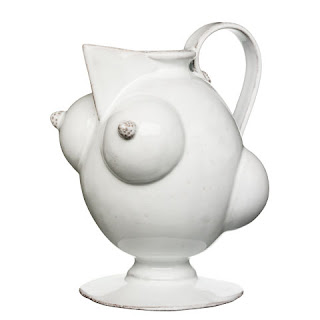
A great Soho design store, Moss...mossonline. Their Aphrodite pitcher reminds me of a plant I saw at Wave Hill in the Bronx,
the nipple fruit: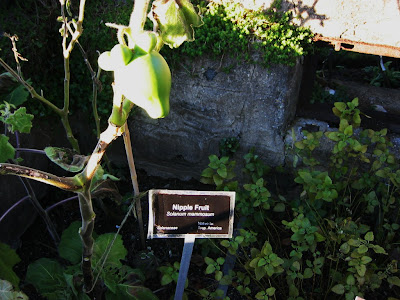
Not sure know why.
I had a great oyster from Duxbury, MA a little while back at B & G Oysters. I found these Duxburys at my local whole foods last night and brought a few home (something I rarely do because I can't open them without gouging my hand open usually). They were fantastic with a shallot-ponzu-rice wine vinegar mignonette.
I woke up this morning thinking about cayenne and pomegranate. Here is my experiment with cayenne and pomegranate braised short ribs.
1. take a couple bone-in short ribs
2. rub them with coarse salt, back pepper and cayenne
3. brown them on all sides in a tablespoon of olive oil
4. remove them, and then soften some rough-chopped celery, carrot, and shallot in the same pan.
The umami gets released as the miripoix cooks.
5. deglaze with a cup of pinot noir or syrah
6. add a cup or so of good stock and pomegranate juice (I knew there had to be some use for POM), let these meld together
7. add back the short ribs and some thyme, cover and simmer for a couple hours.
8. remove the short ribs and strain the braising liquid; add a little more cayenne, then reduce this until there are just a couple tablespoons left
9. reheat the short ribs in the reduced braising liquid
10. plate with some carbohydrate such as good bread or egg pasta.
11. Hot and sweet. Yummo.
We will watch every John Waters film
We will read the Sunday Times every time
(I in this order:
week in review
Magazine
Sunday styles
Metro
Real estate
Arts and leisure)
I will try not to crash our volvo,
On our days off we'll laze on the chaise
Flopping gasto journal from my fingers
Two story wall of windows letting something in
Soapstone reverberating like the Getty,
Something needs to shore me up
Something needs to fight for me against all the
Metastatic cancer in the world
I will still be telling
That story of throwing up in the bathroom
Of honmura an
When I'm sixty four
After getting an ileus at yale.
In a dream I have
We will sit back somenight again
Like two figurines next to each other
At the formosa café
With all our friends about us
We will never let the atmosphere
Atomize us again like this,
We will walk our dog in the indifferent night
Petting some cats along the way
I will throw a cigarette into the street
And no pain or consfusion can fastforward our lives
In those kind of lonely nights
We will watch every john waters film.
Grub Street at NY Mag has a great section called The Annotated Dish. This week's feature on Le Bernardin’s surf and turf (Kobe steak and grilled escolar), includes a Kimchee à la minute which is a single leaf of Napa cabbage marinated in korean barbeque sauce. I love to quick pickle things, and my latest experiments involve both baby cucumbers and Napa cabbage. Here's the process, which is the same for whatever you'd like to pickle, as long as it has a relatively high water content (so it can equilibrate with the salinity of the pickling liquid . . . or something like that):
Sometimes art can be found in unexpected places. Here is a sculpture by Isamu Noguchi in an otherwise featureless corner of Mount Sinai Hospital.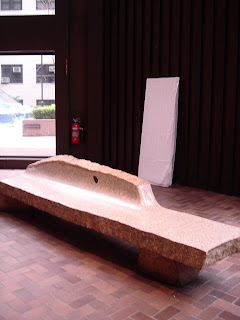
You can visit the Noguchi Museum in Long Island City near P.S. 1.
The best gauge of what someone's concept of "comfort food" is might be the first dinner they cook for themselves in a new home. It is sort of the inverse of a last meal, but the two might be similarly revealing. Grilled cheddar with maple bacon, spicy pickled green beans (I found the ones that Stand includes in their pot of pickles - they're Rick's Picks 'Mean Beans') and garlicky dill slices, sunflower greens with a simple vinaigrette, and a Harpoon summer beer.
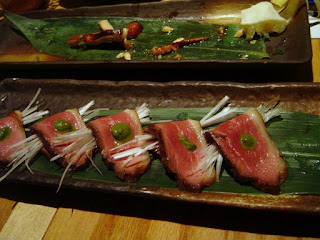
Thinly sliced duck breast, wrapped around some Julienned scallions, with a drop of (maybe) wasabe/edamame puree. The duck was rare, but the fat had a nice prosciutto-like quality. In the background is some grilled Japanese squid with miso and raw ginger I laid waste to. This non-presupposing restaurant in midtown is like a less rarified Momofuku Ssam. Sakagura, 211 E. 43rd Street,
Sometimes considered the measure of a cook's mastery of the basics, a good roast chicken. This is a simple method adapted from Thomas Keller's Bouchon cookbook. He serves it with French green lentils, pearl onions, button mushrooms, bacon lardons, and sauce Chasseur (hunter-style sauce of mushrooms, shallots, and wine) . . . probably none of which are necessary.
1. Start with a chicken that weighs between 2 and 3 pounds. Rinse it really well under cold water, and dry it thoroughly (inside and out) or it'll end up steaming instead of roasting. Salt the inside and outside with a good amount of coarse sea salt and black pepper. 
2. Heat the oven to 450F; meanwhile, truss the bird: 

A classic paper by Yarbus in 1967 tracking saccadic eye movements when subjects looked at Ilya Repin’s The Unexpected Visitor (1884), and asked: 1) free examination of the picture, 2) estimate the material circumstances of the family, 3) give the ages of the people, 4) surmise what the family had been doing before the arrival of the "unexpected visitor," 5) remember the clothes worn by the people, 6) remember the position of the people and objects in the room, and 7) estimate how long the "unexpected visitor" had been away from the family.
Also see meatpaper, the magazine about meat.
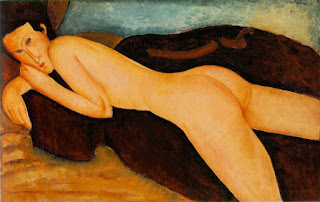 My favorite nude, by Modigliani. Visit the face transformer, upload a picture of yourself, and see yourself as a Modigliani.
My favorite nude, by Modigliani. Visit the face transformer, upload a picture of yourself, and see yourself as a Modigliani.
It's already a bit passe, but sous-vide ("under vacuum") is a method of cooking which involves sealing food in air-tight plastic and cooking it in a tightly temperature-regulated water bath, usually at a low temperature for a long time. The main advantage is that this method is basically the only way to cook something while keeping the integrety of the food completely intact. You essentially (in theory) end up with every molecule you started with in the final result.
Here is an experiment I did with sous-vide duck breast:
1. Start with a nice duck breast, with some garlic, orange peel, thyme, salt and pepper.
2. Seal it all together in an air-tight plastic bag that can withstand near boiling (I used a cheap Seal-a-Meal...but these machines can be ridiculously expensive).

3. Immerse in a water bath that is maintained at around 130F (a laboratory thermoimmersion water bath would be best, but I just balance a thermometer on the edge of the pot and adjust the heat). The larger the volume of water you can use, the more constant the temperature will be. Let this sit in the water for 2 hours..up to 12 hours (at maybe a slightly lower temperature).
4. Remove the breast and open the bag carefully. 
5. Essentially, it's done.
The next steps are optional:
6. Fire it in a pan to crisp up the skin.
8. Deglaze the pan with a little Gran Marnier. Set it afire.
